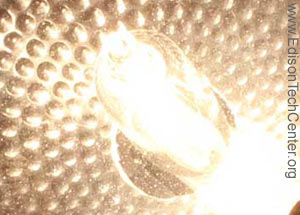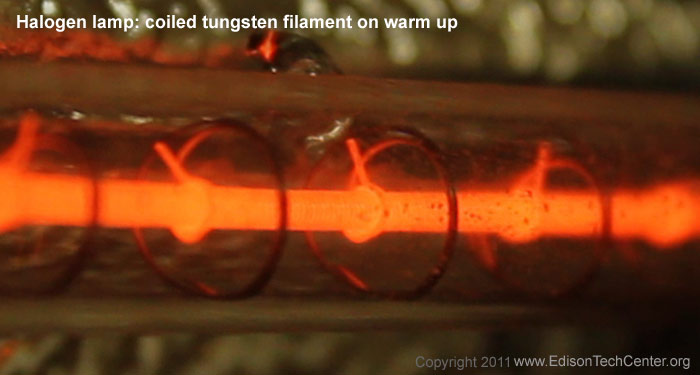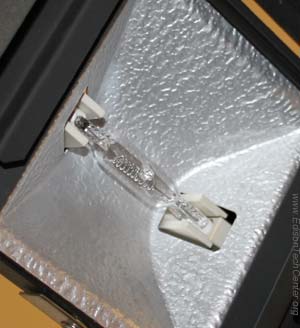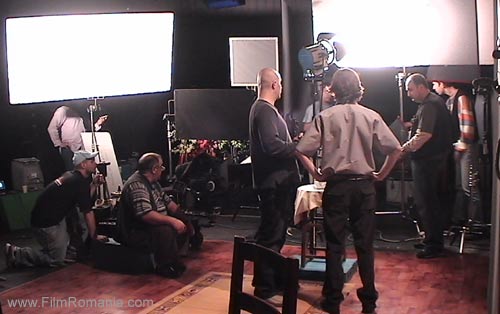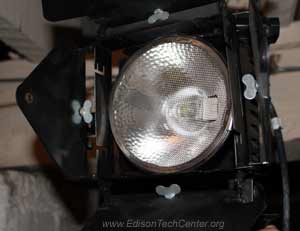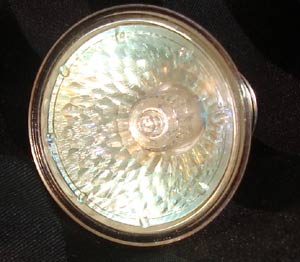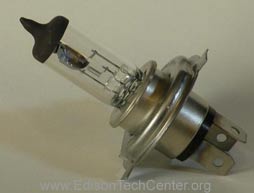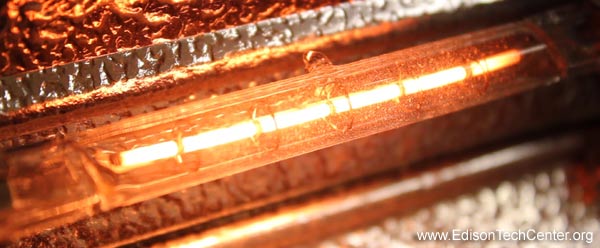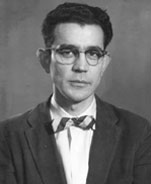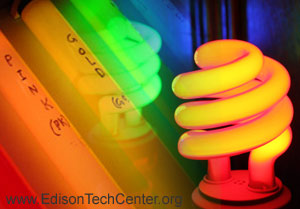The Halogen Lamp
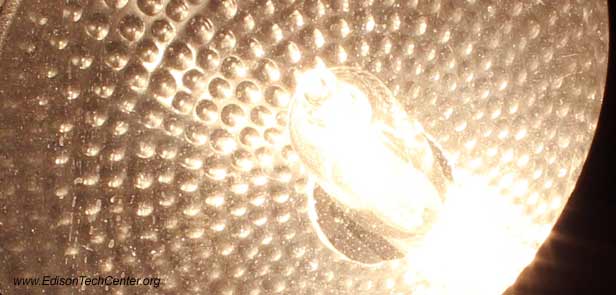 |
Bright and Compact
History (1953 - Today)
Introduction & Statistics
Design Variations
Inventors and Developments
Introduction:
The halogen lamp is also known as a quartz halogen and tungsten halogen lamp. It is an advanced form of incandescent lamp. The filament is composed of ductile tungsten and located in a gas filled bulb just like a standard tungsten bulb, however the gas in a halogen bulb is at a higher pressure (7-8 ATM). The glass bulb is made of fused quartz, high-silica glass or aluminosilicate. This bulb is stronger than standard glass in order to contain the high pressure. This lamp has been an industry standard for work lights and film/television lighting due to compact size and high lumen output. The halogen lamp is being replaced slowly by the white LED array lamp, miniature HID and fluorescent lamps. Increased efficiency halogens with 30+ lumens per watt may change sale decline in the future.All credits and sources are located at the bottom of each lighting page
Advantages/Disadvantages:
Advantages:
-Halogen Lamps are small, lightweight
-Low cost to produce
-Does not use mercury like CFLs(fluorescent) or mercury vapor lights
-Better color temperature than standard tungsten (2800-3400 Kelvin), it is closer to sunlight than the more "orangy" standard tungsten.
-Longer life than a conventional incandescent
-Instant on to full brightness, no warm up time, and it is dimmableDisadvantages:
-Extremely hot (easily capable of causing severe burns if the lamp is touched).
-The lamp is sensitive to oils left by the human skin, if you touch the bulb with your bare hands the oil left behind will heat up once the bulb is activated, this oil may cause an imbalance and result in a rupture of the bulb.
-Explosion, the bulb is capable of blowing and sending hot glass shards outward. A screen or layer of glass on the outside of the lamp can protect users.
-Not as efficient as HID lamps (Metal Halide and HPS lamps)
Video. 6 minutes. (YouTube must not be blocked on your server and flash plug-ins required)
|
|
|
| 1. How it Works | 2. Variations & Uses | 3. Inventors & Developments |
The halogen lamp has a tungsten filament similar to the standard incandescent lamp, however the lamp is much smaller for the same wattage, and contains a halogen gas in the bulb. The halogen is important in that is stops the blackening and slows the thinning of the tungsten filament. This lengthens the life of the bulb and allows the tungsten to safely reach higher temperatures (therefore makes more light). The bulb must be able to stand higher temperatures so fused quartz is often used instead of normal silica glass.
A halogen is a monovalent element which readily forms negative ions. There are 5 halogens: fluorine, chlorine, bromine, iodine, and astatine. Only Iodine and Bromine are used in halogen tungsten lamps.
A.) The lamp is turned on and the filament begins to glow red as more current passes through it. The temperature rapidly increases. The halogens boil to a gas at relatively low temperatures: Iodine (184 C) or Bromine (59 C).
B.) Normally tungsten atoms evaporate off of the filament and deposit on the inside of the bulb, this blackens normal incandescent lamps. As atoms leave the filament the filament gets thinner. Eventually the filament breaks (usually at the ends of the filament). In a halogen tungsten lamp the tungsten atoms chemically unite with the halogen gas molecules and when the halogen cools, the tungsten is redeposited back on the filament. This process is called the halogen cycle.
Double ended halogen bulb (400 Watts)The halogen bulb comes in two basic configurations: single and double ended. The most common halogen lamps are double ended, these generally are the larger wattage lamps and are used for work lights, yard lights and film production lamps. The halogen lamp has an instant 'on' ability unlike mercury vapor or high pressure sodium, therefore they work well for security lamps that are activated by motion sensors. The life of a halogen lamp is shortened by frequent on and off cycles.
Filaments in a doubled ended halogen may be straight or double coiled. All filaments are coiled to increase brightness, this was a development by Irving Langmuir in the standard incandescent bulb.
A screen is used to protect actors from violent failures at the end of bulb life (bulb may burst from high pressure)
Halogen lamps used for television and film production range from 125-750+ Watts. The high consumption limits the number of lamps one can plug in to a standard 15 Amp circuit. Each year LEDs, HMIs, and daylight fluorescents replace the halogen lamp due to reduced fire hazard (less heat) and power consumption.
Another use of halogen lamps which has grown since the mid 1990s has been home and commercial lighting. The halogen track light is a popular way to provide quality light to specific areas for food preparation, paintings/wall hangings, and general mood lighting. The halogen lamp is fully dimmable unlike compact fluorescent lamps. The halogen consumes very little energy and has a longer life when dimmed. Frederick Mosby developed early halogen fixtures with standard edison screw in bases for use in the home as early as the mid-1960s.
The MR16 lamp (left) is used in many modern track lighting fixtures.
The lamp above is a newer halogen used in car headlights. Sylvania has a product called "Blue Star" which uses a halogen light and filters it to create a blue color. This creates a poorer color rendition than standard tungsten. The deregulation of headlights in cars has lead to more variety in available lamps.Elmer Fridrich and Emmet Wiley developed the halogen lamp at General Electric in Nela Park, Ohio in 1955. Others had tried to build halogen lamps, however they could not figure out how to stop the blackening of the lamp. Fridrich figured out that one had to use a small amount of iodine surrounding the tungsten filament, which would allow it to burn at elevated temperatures. The early lamps were used and designed to "bake" paint onto metal using the high heat output of the halogen.
The double ended halogen lamp was patented in 1959 in Nela Park (Cleveland, OH)Patents were issued in 1959, and by 1960 the halogen was improved upon by other engineers so that it was cheaper to produce and market. Since the 1980s the lamps have been made lighter in weight.
Early work done before the 1950s includes William D. Coolidge's work developing ductile tungsten in 1911. This material is used in many lamp types including the halogen lamp. Irving Langmuir studied gas filling and doping of tungsten to lengthen bulb life from 1905 - 1940s.
|
|
|
 |
|
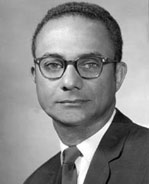 |
|
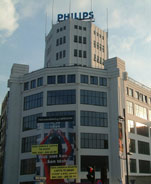 |
|
Lamps are presented in the order of chronological development
|
Previous: Fluorescent Lamps 1934 |
Next:
EL Lamps 1958
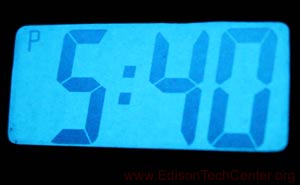 |
 |
|
Arc
- Incandescent - Nernst
- Neon - Mercury
Vapor - Sodium Lamp - Fluorescent
- Halogen - EL
- LED - MH
- Induction
|
COMMENTS?
Help us edit and add to this page by becoming a ETC volunteer!
Give us feedback
on this and other pages using our Facebook
Page
Back
to Home
Written
by M.Whelan with additional research by Rick DeLair
Please contact us if you are a historian and wish to correct or improve
this document.
Sources:
"At 88, halogen lamp inventor Elmer Fridrich still coming up with
bright ideas" by Roger Mezgar, Cleveland.com
How Halogen Works. www.sylvania.com
The Subdivision of the Light by Unknown
"A
History of Electric Light and Power" by B. Bowers
Photos:
Edison Tech Center
Whelan Communications
Schenectady Museum
Photo/Video
use:
Commercial entities must pay for use of photos/graphics/videos in their
web pages/videos/publications
No one commercial or public is allow to alter Edison Tech Center photos/graphics/videos.
Educational Use: Students and teachers may use photos and videos for school.
Graphics and photos must retain the Edison Tech Center watermark or captions
and remain unmanipulated except for sizing.
Permissions
- Videos: We do not email, FTP, or send videos/graphics to anyone
except in DVD form. Payment is needed for this service. See our donate
page for pricing, and our catalogue
for a listing of videos on DVD.
Professional video production companies may get videos in data form with
signed license agreements and payment at commercial rates.
Copyright
2013 Edison Tech Center

